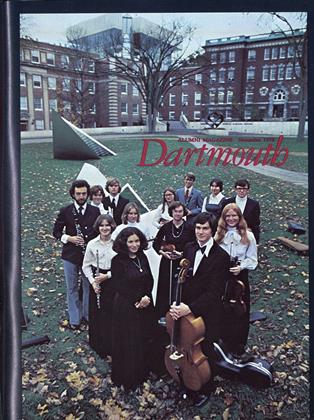A traditional four-year program, a bigger tuition bill, and much of the clinical training taken at a distant site: all these may well be on the books for students entering the Dartmouth Medical School in 1980 and after. In addition, if all these changes come to pass, there will probably be more students.
A faculty committee charged with seeking long-range solutions to the Medical School's continuing fiscal woes has recommended that the much-heralded three-year program be abandoned in favor of the conventional four-year curriculum; that tuition be raised to an annual $8,000 - this year students are paying $7,015 for the 11-month Phase I and $7,665 for each of the year-long Phases II and III; and that the size of each entering class be,increased by 30 or 40 per cent, a move that would come close to doubling the overall size of the student body, even though many of the additional students would be off campus.
The curricular change, while increasing tuition revenue substantially, would also provide an answer to objections voiced last year by another faculty committee to the pace and pressure of the three-year program, described in their report as "unrelenting from matriculation through the basic clinical clerkships."
The studies suggest, Medical School Dean James Strickler '50 says, that "the modest increase now under consideration - 26 students per class - could be accommodated in the pre-clinical years without substantial increase in expenses." There would be more students in classrooms, but generally facilities would be adequate for the roughly 50 more men and women enrolled in the first two years of the program. The rub, however, comes with the clinical years, when teaching is often on a one-to-one basis. Because of limited clinical facilities at Mary Hitchcock Hospital and the Veterans Hospital in White River Junction, medical school personnel have investigated the potential of three other teaching hospitals, including one in San Francisco, as off-campus sites for Dartmouth students' clinical training.
Except for the "modest increase" in the number of students in Hanover classrooms, however, the change is probably not as radical as it might first appear. The Medical School, its current enrollment of 192 making it the second smallest in the U.S., would remain small even with 360 students overall, in comparison with a national mean of 500. Although the cost of a medical education at Dartmouth would increase t an estimated $8,000 at the start of the 1980-81 academic year, Associate Dean Philip Nice points out that substantial increases would undoubtedly occur in the normal course of events in that interval. Tuition for the three-year program has almost doubled within the past five years, from $11,990 in 1973-74, to the current $22,345. Dean Strickler notes in his summer newsletter that, at $8,000 a year, "Dartmouth would still be competitive at this time with other schools with which we compete for the nation's top students." Nor is there anything new in off-campus "clerkships," as segments of clinical training in various specialities are called. In addition to clerkships at Mary Hitchcock and the local VA hospital, all departments except medicine and psychiatry already offer external clerkships — in several small hospitals in northern New England and in Tuba, Arizona, for primary care; in Hartford, Connecticut, for surgery; in Los Angeles and Concord, New Hampshire, for obstetrics-gynecology; in Waterbury (Conn.) Hospital and with Upper Valley private practitioners for pediatrics.
The Medical School curriculum committee is currently fleshing out the details of a possible four-year program, Dr. Nice says, and estimating the cost of implementing such a change. The board of overseers has recently met in Hanover to consider the proposals, and a visiting committee of medical educators from other institutions has been invited to offer counsel to President Kemeny and the Trustees of the College. Their decision is expected within the next several months.
 View Full Issue
View Full Issue
More From This Issue
-
 Feature
FeatureThe Researcher and the Teacher
November 1978 By Shelby Grantham -
 Feature
FeatureJazz Comes to College
November 1978 By Dick Holbrook -
 Feature
Feature'A hell of a lot of life gone by'
November 1978 By Dan Nelson -
 Feature
FeatureMaking Music
November 1978 By Dana Grossman -
 Article
ArticleThe Joy of Moving
November 1978 By W.B.C. -
 Article
ArticleMan of the Cloth
November 1978 By M.B.R.







